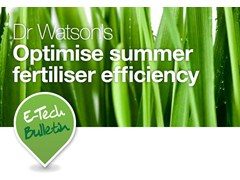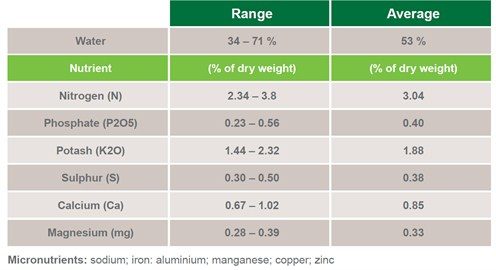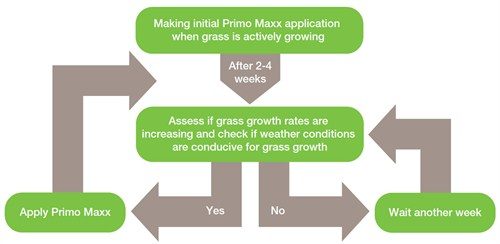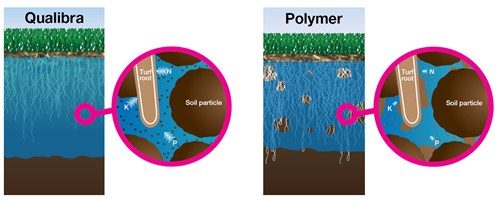
The removal of grass clippings with every cut takes away nutrients that must be replaced to maintain turf health. Therefore, reducing the clipping yield with a growth regulator programme should correspondingly make more efficient use of fertiliser inputs, whilst maintaining turf colour and health.
All nutrients are removed in grass clippings - with nitrogen (N) the major nutrient component, along with potassium (K) and, to a lesser extent, phosphorus and calcium.
Water and nutrient loss through clippings:

The nutrient content equates to around 14kg of N per tonne of fresh grass clippings, along with nine kg of K2O.
Regulating turf growth and clipping removal can enable turf managers and agronomists to be more accurate in their use of fertiliser applications that are better matched to growing conditions and the specific requirements of the turf, to maintain high quality playing surfaces.
More efficient targeted use of nitrogen will prove to be cost effective and good for the environment.
The reduction in clippings - typically averaging 25% across the season, but up to 40% during peak growing conditions directly after Primo Maxx treatment - also give corresponding reductions in:
• Mowing costs • Time • Carbon footprint
Trials results
Three years research trials*1 on bentgrass greens showed that in normal growing conditions the Primo Maxx programme enabled a 25% reduction of N application, from a typical 15kg/ha to 11kg every two weeks, without affecting turf quality.
Also, the residual balance of fertiliser input to nutrient removal in clippings (the input-output N budget) remained unchanged; indicating a sustainable fertiliser regime.
Furthermore, the researchers concluded that ball roll distances may likely benefit from the reduced clipping yield as a cumulative effect of lower N nutrition and regulating turf growth.
The trials demonstrated that the nutrient input is an essential factor of turf colour and visual quality. It was only the combination of reduced N and the use of Primo Maxx that was able to maintain the desired colour and surface quality.
*1 Undertaken by William Kreuser of Cornell University and Douglas Soldart of the University of Wisconsin-Madison and published in Crop Science magazine
Fertiliser recommendations
These results confirm the recommendations to include a high quality liquid N feed with every application of Primo Maxx, but that overall there is potential to make more efficient use of fertiliser programmes over the course of the season.
For greens, the recommendation would typically be Primo Maxx at 0.4 l/ha plus Everris Greenmaster Liquid High N 25-0-0+2MgO+TE at 40 l/ha. To maintain consistent growth regulation and turf health, this application would typically be repeated at two to four week intervals.
In practice, many greenkeepers adopt a 'little and often' approach, possibly using a half rate of Primo Maxx and fertiliser, but applied at fortnightly intervals. The precise timing and application rate can be varied according to turf species and prevailing growing conditions, as shown below:

During peak growing conditions over the summer, any nutrient stress could exacerbate root mass die back as plants seek to conserve carbohydrates. Primo Maxx programmes have consistently shown to retain healthy root systems more effectively over the summer, which also serves to further enhance nutrient and water uptake from the soil, as well minimise effects of heat and drought.
Primo Maxx has also been shown to increase levels of cytokinins that are crucial to help plants withstand summer heat and drought stress more effectively, as well as increasing the concentration of chlorophyll to maintain visual colour.

Rooting out nutrients
The efficiency of summer nutrient uptake could be further enhanced by improved retention and distribution of soil moisture throughout the root zone. Where Dry Patch is an issue, there can be pockets alongside roots within the soil profile with no available moisture or nutrients - even in a wet year.
New trials are looking at how using Qualibra wetting and water conservation agent could improve deep and even soil moisture distribution and increase the area of root contact - thereby increasing water and nutrient uptake.

Retaining soil moisture and soluble nutrition in the root zone for longer could also aid overall plant uptake and utilisation.
The combination of increased root mass and greater soil moisture contact would explain the health and colour improvements seen by greenkeepers.
In addition to improving efficiency of fertiliser applications, this benefit could also be seen with the bio-stimulant Vitanova Blade to fully utilise the nutrients released.

|
|
| |
| |
| |
|
Click here to download a PDF version of the E-Tech Bulletin - Optimise fertilser efficiency
